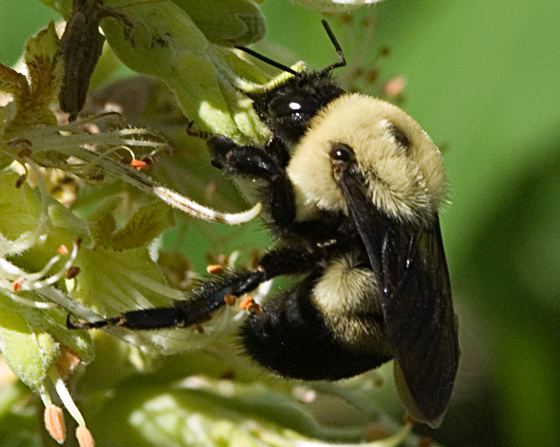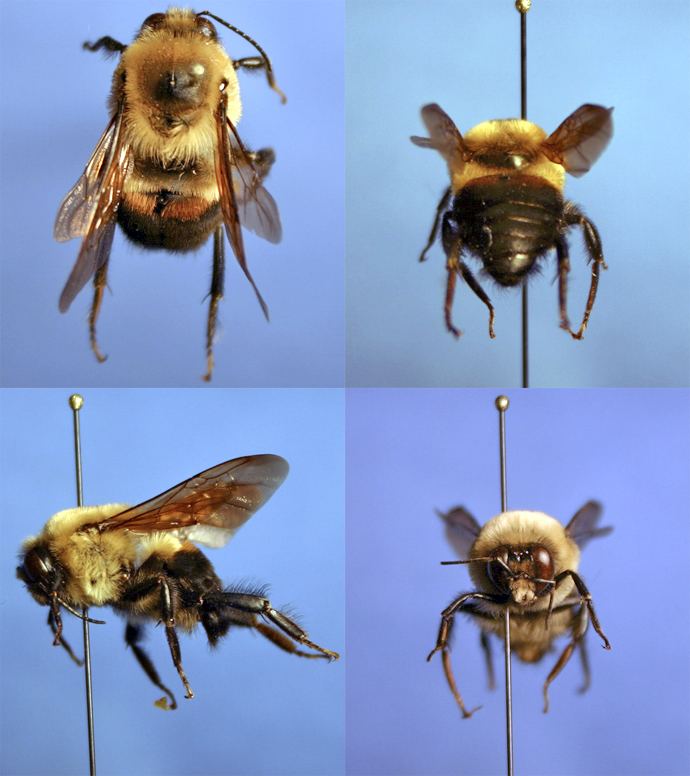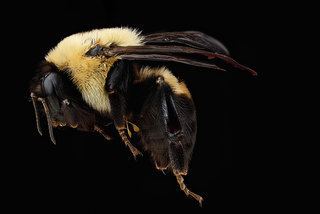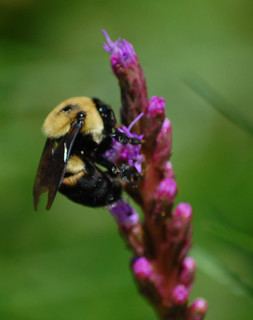Subphylum Hexapoda Rank Species | ||
 | ||
Similar Two‑spotted bumble bee, Bombus auricomus, Bombus vagans, Bombus nevadensis, Bombus perplexus | ||
Bombus griseocollis
Bombus griseocollis is a species of bumblebee known commonly as the brown-belted bumblebee. It is native to much of the United States except for the Southwest, and to the southernmost regions of several of the provinces of Canada.
Contents

Description

The queen is 2.1 to 2.3 centimeters long and about a centimeter wide at the abdomen. Its head and face are black with scattered yellow hairs. The thorax is coated in yellow hairs. The abdomen is yellow banded with black, with a black posterior and black ventral surface. The legs are black.

Workers are smaller than the queen, sometimes less than a centimeter long. They are similar in color pattern, but may have a brown-yellow band around the abdomen.

Males are about 1.5 to 1.9 centimeters long and about 0.7 centimeters wide at the abdomen. They have very large eyes that span about two thirds the width of the head. The face and thorax have yellow hairs and the abdomen is banded with yellow, yellow-brown, and black.
Biology

This bumblebee can occupy many kinds of habitat, including meadows, wetlands, agricultural fields, and urban areas, even densely populated cities. It is a common pollinator in community gardens in New York City and it has been observed near the top of the Empire State Building over 100 stories above ground level.

This bee feeds at many kinds of plants, such as milkweeds, prairie clovers, echinaceas, loosestrife, bergamot, pickerel weeds, rudbeckias, goldenrods, clovers, and vetches. The queens particularly favor legumes.

This species nests underground or on the surface. Nests are generally small colonies of fewer than 50 workers, but they aggressively defend their establishments. This is a eusocial bee, one that forms a colony that works together to rear young with labor divided amongst reproductive and non-reproductive castes. All the daily tasks in the nest are performed by worker bees of all age groups, but each age group specializes in a certain duties. The youngest workers, those just a few hours old, assist in incubating the pupae. Young workers in the next stage leave the nest to forage and defend the colony, and return to help feed the larvae. Older workers tend to work on building the nest and its honey chambers using wax. The oldest workers are more sedentary and more likely to stay and help incubate young. The queen has the task of laying eggs; as she becomes less fertile, aggressive young workers may battle for the opportunity to become the egg-layer.
Specific tasks performed by workers include secreting wax and using it to glue the nest to a substrate, using harvested material to insulate the nest, incubating pupae by wrapping their bodies around the cocoons, regurgitating food for larvae, scraping wax off of discarded pupal cases and recycling it in the construction of honey pots, buzzing when alarmed, inspecting and patrolling the nest, foraging, and feeding.
Males perform the task of inseminating queens. They perch in areas where young queens might pass, awaiting mating opportunities. They scent mark their perches using a glandular secretion containing tetradecyl acetate and butyric acid. This is likely a signal to other males rather than to females. Males of this species also help to incubate pupae, a task done only by workers in most bee species.
Conservation
This is a common species in much of its wide range. Unlike many bumblebees in North America, it has experienced an average decline of 0%, and in some areas its populations may be increasing. It apparently faces no serious threats.
